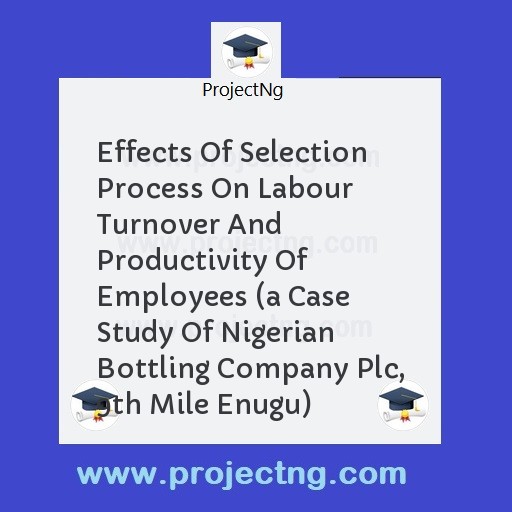Effects Of Selection Process On Labour Turnover And Productivity Of Employees (a Case Study Of Nigerian Bottling Company Plc, 9th Mile Enugu)
Accounting Project Topics
Get the Complete Project Materials Now! »
EFFECTS OF SELECTION PROCESS ON LABOUR TURNOVER AND PRODUCTIVITY OF EMPLOYEES
(A CASE STUDY OF NIGERIAN BOTTLING COMPANY PLC, 9TH MILE ENUGU)
ABSTRACT
Human resources and organization are like two sides of coin. For organization to exist, it requires human effort to carry-out the activities for achieving the purpose of such organization . Again how this organization select and recruits, employees who are competent without bias mind was seen as part of the researcher’s reasons for carrying out the study.
Recruitment according to Udeze J.O.(2000) quoted from Flippo Munsiger(1978) defines or sees recruitment as the process of searching for perspective employees and stimulating them to apply for jobs. While selection is aimed at selecting the best from the tools of qualified applicant to a job opening unquoted . this means that selection brings to an end, the function of category of procurement.
This study was aimed at understanding the problem of selection process on labour turn-over in Nigeria Bottling company Plc Enugu. And also to a certain the extent to which the company ownership structure with its attendant bureaucratic re tape in the company and how to alleviate them.
The researcher identifies means by which selection process can be improved and also proffer solution and recommendation.
TABLE OF CONTENT
Title page
Approval page
Certification
Acknowledgement
Dedication
Abstract
Table of contents
List of tables
CHAPTER ONE
Introduction
1.2 Background of the study
1.3 Statement of the problem
1.4 Objectives of the study
1.5 Significance of the study
1.6 Research Questions
1.7 Scope and limitation of the study
1.8 References
CHAPTER TWO
LITERATURE REVIEW
2.1 Introduction
2.2 Selection policy
2.3 Criteria for selection
2.4 Selection process
2.5 Application form
2.6 The nature and objective selection interview
2.7 Conducting the interview
2.8 Psychological test
2.9 Coefficient of correlation
2.10 Acceptance of the job offer
2.11 Evaluation of the Nigerian Bottling company
Plc 9th Mile, Enugu Plant
Reference
CHAPTER THREE
RESEARCH METHODOLOGY
3.1 Introduction
3.2 Research Design
3.3 Population for the study
3.4 Sample size determination
3.5 Source of data
3.6 Collection of data
3.7 Data analysis technique
CHAPTER FOUR
PRESENTATION AND ANALYSIS OF DATA
4.1 Introduction
4.2 Tabular presentation descriptive analysis and introduction of data
4.3 Summary
CHAPTER FIVE
5.1 Summary
5.2 Conclusion
5.3 Recommendation
5.4 Bibliography
5.5 Appendices
LIST OF TABLES
Table 4 -1 Type of questionnaire
Table4 –1-2 Selection process is based on
Table4 –1-3 Has the turn- over and productivity affected masses.
Table4 –1-4 How often do the selectors exchange view concerning selection process of employees in their monthly meeting.
Table4 – 1-5 Do you think selectors have what is expected in selection process of employees?
Table 4 –1-6 Is there any policy made for effective selection in your company?
Table 4 –1-7 Are the policy made related to the company’s objectives?
Table 4 –1-8 How often are the employees exposed to technical programmes?
Table 4 –1-9 Who has the right to select in the company?
Table 4 –1-10 Are you satisfied with the selection of employees in the company?
CHAPTER ONE
INTRODUCTON
1.1 BACKGROUND OF STUDY
Every organization has human resources as part of its resources. The organization cannot function without people working together and whenever people work together, the personnel management function must be performed and executed. Other resources may include physical, financial and informational. However, the most vital among all these resources seems to be the human element.
The human resources is the concern of personnel management. Personnel management deals with the bringing of a person into an organization, his behaviour in the work situation, his interests and relation-ship both with his fellow workers and the organization. It is the series of management activities, which procures personnel for the organization to achieve effectives performance towards organizational growth.
Therefore this human element does not just come, they are recruited based on qualification. Recruitment is an of the process of staffing in an organization. It is also concerned with developing a pool of job candidate in line with the human resources plan. In this case, candidates are usually located through newspapers and professional journal advertisements, employment agencies and visits campus. It comes immediately after human resources planning. Recruitment
Seen as that process of assessing a job, announcing the vacancy, arousing interest and stimulating people to apply
In recruitment, there is general one is the most appropriate for operative employees, which takes place if the organization needs a group of workers of a certain type, example is typists or sales people. Another one is specialized recruiting, which is used mainly for executives or specialists, occurs when the organization desires s particular. In this , candidates receive individual attention over an extended period of time. The process of recruitment must be centered in one place and in the hands of one person or group. Only in this way can there be a sufficient concentration of exercise, knowledge and record to provide the possibility of efficiency in service both to applicants and to the organization.
While selection is the process that leads the firm to choose from a list of applicant. The person or persons who will match the selection criteria or the
Be the First to Share On Social

Enjoying our content?
Don't miss out on new videos! Subscribe to our YouTube channel for more awesome content.
Subscribe Now!













